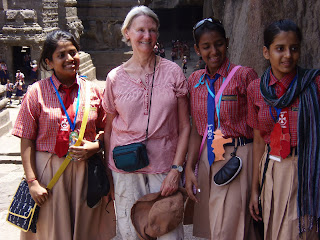Ellora
Train to Aurangabad. Got up at 4:00. Our cheery driver was at the hotel at exactly 4:30 and got us to Victoria Station (now called CST) in plenty of time. Obviously sleeping on the floor in the station is a common practice.
We have an air-conditioned car obviously fairly old, but it has AC so we're happy. Many passengers get off the train at each stop to stretch. We passed lots of different agricultural areas growing oranges (more like our tangerines), millet, corn, wheat and table grapes.
Some areas had similarities Arizona and New Mexico, arid with interesting rock formations, started by volcanic action and carved by erosion.
When we met our tour guide and got started out of town we passed the ruins of Daulatabad, a citadel fort that was created in the 13th century. There are actually four concentric walls (outer one in foreground) surrounding the fort built out of basalt, the volcanic rock that forms the 600 foot high peak where the king resided. The reason the sides of the hill are so straight is that all of the concentric walls were built with blocks of basalt that were cut from the lower part of the hill using only hand chisels and hammers. People here were really into stone cutting, as we found out at the next stop.
The feature of the day were the Jain, Hindu and Buddhist temples at Ellora. These monuments were cut out of the basalt ( a porous volcanic stone that is harder than sandstone but still can be carved in detail) hills during the 7th to 9th centuries. It says something about tolerance of the rulers that the three religions carved out temples in the same spot.
They started from the top of the hill side and cut down into the rock so that each temple is actually formed from a single piece of rock. It is an amazing feat, like building the pyramids it took generations of craftsmen.
They started from the top of the hill side and cut down into the rock so that each temple is actually formed from a single piece of rock. It is an amazing feat, like building the pyramids it took generations of craftsmen.
Although the plaster is mostly gone, in addition to the intricate carving they had beautiflyl frescos covering the walls.
The largest Hindu temple (Kailasanatha) was started in the 8th century and was never totally finished. Once it was partially damaged by invaders it was never finished. It is so massive that it is estimated that the rock that was chiseled out amounted to over 3 million cubic feet. Worth a Google. Parts of the temples eroded and some were damaged by local villagers who lived in them and covered many of the ceiling frescos with soot from their cooking fires.
Our guide was great at trying to get us into the best position to get good photos. He was also quite tolerant of all the school girls who wanted their pictures taken with Eva, taking numerous shots so that each girl had it on her phone or camera. It is so fun to be the object of stairs and giggles because we are white and different from all of them. The hundreds of boy students also wanted pictures with us but were much less well behaved. The guards had to keep blowing their whistles to get the boys down off of the carved pillars and statues.
Kick boxing was practiced by the Hindu gods. Some of the frescos above the kick boxers were still intact.
As in the Jain temples in Ranakpur, these had statues of their firs prophet but also had Hindu-looking statues in them. The idea that these temples were started at the front and carved back into the mountain with such detail and precision is mind-blowing.
The Buddhist temple that dates from the 7th century has an amazing arched hall with a very peaceful Buddha. They actually made the solid stone look like a wood structure with beams and rafters.
As in the Jain temples in Ranakpur, these had statues of their firs prophet but also had Hindu-looking statues in them. The idea that these temples were started at the front and carved back into the mountain with such detail and precision is mind-blowing.













No comments:
Post a Comment